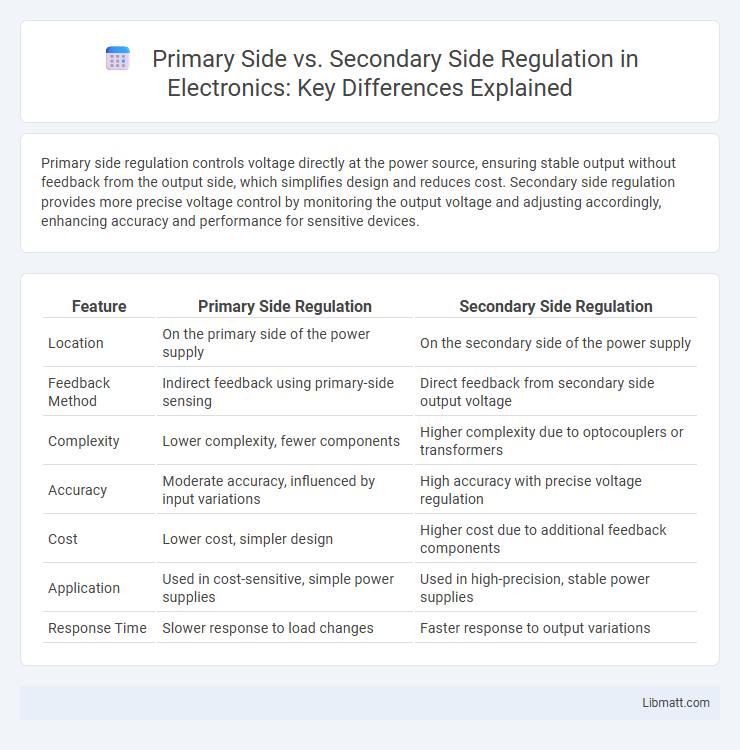Primary side regulation controls voltage directly at the power source, ensuring stable output without feedback from the output side, which simplifies design and reduces cost. Secondary side regulation provides more precise voltage control by monitoring the output voltage and adjusting accordingly, enhancing accuracy and performance for sensitive devices.
Table of Comparison
| Feature | Primary Side Regulation | Secondary Side Regulation |
|---|---|---|
| Location | On the primary side of the power supply | On the secondary side of the power supply |
| Feedback Method | Indirect feedback using primary-side sensing | Direct feedback from secondary side output voltage |
| Complexity | Lower complexity, fewer components | Higher complexity due to optocouplers or transformers |
| Accuracy | Moderate accuracy, influenced by input variations | High accuracy with precise voltage regulation |
| Cost | Lower cost, simpler design | Higher cost due to additional feedback components |
| Application | Used in cost-sensitive, simple power supplies | Used in high-precision, stable power supplies |
| Response Time | Slower response to load changes | Faster response to output variations |
Understanding Primary Side Regulation
Primary side regulation controls output voltage by sensing parameters directly on the primary side of a transformer, eliminating the need for an optocoupler or secondary feedback components. This method uses the primary current and voltage waveforms to infer load conditions and adjust switching accordingly, improving reliability and reducing component cost. Primary side regulation is common in low- to medium-power isolated power supplies due to its simplicity and cost-effectiveness compared to secondary side feedback systems.
Exploring Secondary Side Regulation
Secondary side regulation enhances voltage stability by directly controlling the output voltage through feedback on the transformer's secondary winding. This method offers superior accuracy in maintaining consistent voltage levels under varying load conditions compared to primary side regulation. Understanding secondary side regulation can help you optimize power supply designs for better performance and reliability.
Key Differences Between Primary and Secondary Side Regulation
Primary side regulation controls output voltage by adjusting the duty cycle of the transformer's primary switch without direct feedback from the output, resulting in reduced component count and cost. Secondary side regulation uses feedback from the output voltage, often via an optocoupler, to achieve higher accuracy and tighter voltage regulation. Your choice between primary and secondary side regulation depends on the required precision, cost constraints, and complexity of the power supply design.
Applications of Primary Side Regulation
Primary Side Regulation is widely used in isolated power supplies, especially in low- to medium-power applications like chargers, adapters, and small consumer electronics, where it simplifies design by eliminating the need for secondary-side feedback components. Its cost-efficiency and reduced complexity make it ideal for scenarios requiring basic voltage regulation without tight accuracy constraints. Your choice of Primary Side Regulation enhances reliability and reduces component count in applications prioritizing cost-effective voltage control.
Use Cases for Secondary Side Regulation
Secondary side regulation is commonly used in isolated power supply designs where precise output voltage accuracy is critical despite load variations. It is ideal for applications such as telecom equipment, medical devices, and industrial automation systems where tight voltage control enhances performance and reliability. Secondary side regulation effectively compensates for losses and voltage drops in the transformer and wiring, ensuring consistent output quality.
Advantages of Primary Side Regulation
Primary Side Regulation offers advantages such as simplified circuit design by eliminating the need for optocouplers, which reduces overall cost and complexity in power supply systems. This regulation method enhances reliability since fewer components on the secondary side decrease the risk of failure and maintenance requirements. You benefit from faster response times and improved efficiency, especially in low-power or isolated applications where tight voltage regulation is critical.
Benefits of Secondary Side Regulation
Secondary side regulation offers enhanced voltage accuracy by directly controlling the output voltage at the load, minimizing the impact of load and line variations. It improves transient response and stability, ensuring consistent performance even with dynamic load conditions. This method also reduces the need for tight feedback loop compensation and allows simpler transformer design, contributing to overall system efficiency and reliability.
Challenges and Limitations
Primary side regulation faces challenges in accuracy since it relies on indirect measurements without feedback from the output, making it less effective under varying load conditions. Secondary side regulation offers precise output voltage control by directly sensing the output, but it introduces complexity, cost, and potential stability issues due to the required feedback loop. Your choice between these methods depends on balancing cost constraints with the need for tight voltage regulation and system stability.
Choosing the Right Regulation Method
Choosing the right regulation method between primary side and secondary side regulation depends on the application's sensitivity to output voltage accuracy and cost constraints. Primary side regulation offers simplicity and lower cost by controlling the output indirectly through the primary circuit, ideal for less precise requirements. Secondary side regulation provides tighter voltage regulation by directly sensing the output, making it suitable for applications demanding high accuracy and fast transient response.
Future Trends in Power Supply Regulation
Future trends in power supply regulation emphasize advanced digital control techniques and adaptive regulation on both primary side and secondary side circuits to enhance efficiency and response time. Integration of real-time monitoring and AI-driven optimization enables dynamic adjustment of voltage and current, improving the performance of your power supply systems. Embracing these technologies ensures more precise load regulation and energy savings in next-generation power management designs.
Primary Side vs Secondary Side Regulation Infographic

 libmatt.com
libmatt.com